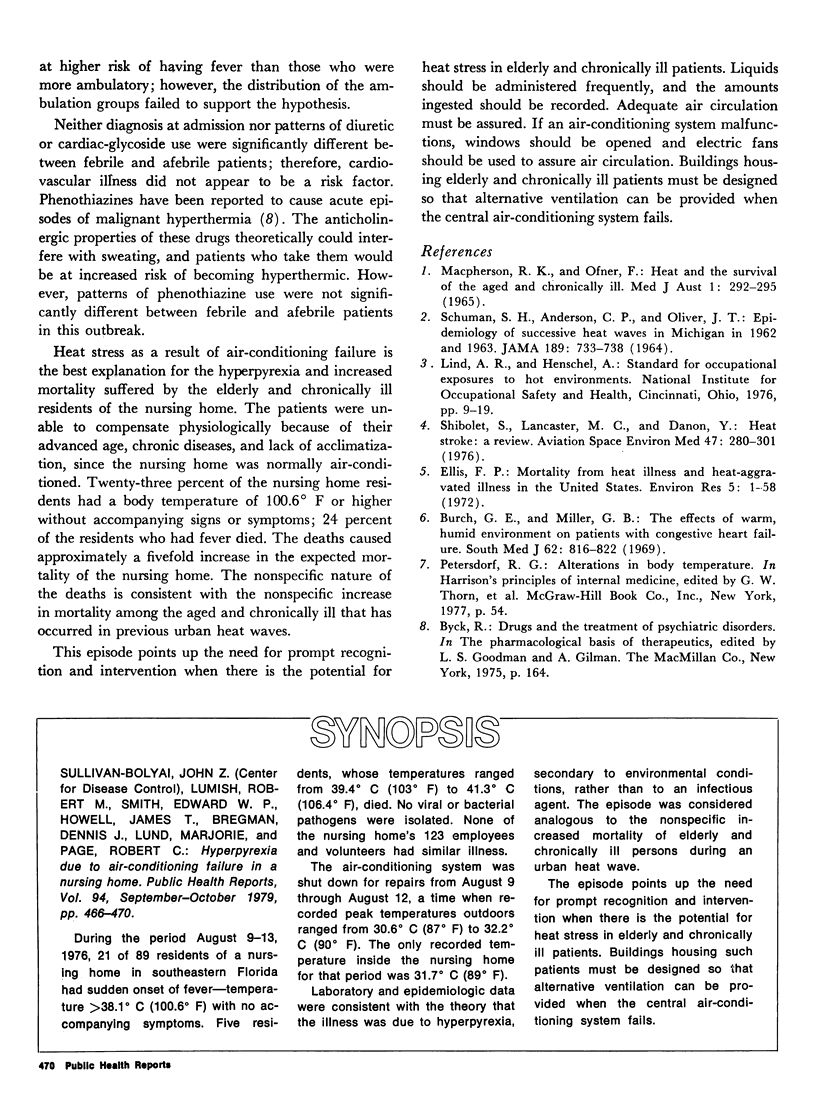Abstract
During the period August 9--13, 1976, 21 of 89 residents of a nursing home in southeastern Florida had sudden onset of fever--temperature greater than 38.1 degrees C (100.6 degrees F) with no accompanying symptoms. Five residents, whose temperatures ranged from 39.4 degrees C (103 degrees F) to 41.3 degrees C (106.4 degrees F), died. No viral or bacterial pathogens were isolated. None of the nursing home's 123 employees and volunteers had similar illness. The air-conditioning system was shut down for repairs from August 9 through August 12, a time when recorded peak temperatures outdoors ranged from 30.6 degrees C (87 degrees F) to 32.2 degrees C (90 degrees F). The only recorded temperature inside the nursing home for that period was 31.7 degrees C (89 degrees F). Laboratory and epidemiologic data were consistent with the theory that the illness was due to hyperpyrexia, secondary to environmental conditions, rather than to an infectious agent. The episode was considered analogous to the nonspecific increased mortality of elderly and chronically ill persons during an urban heat wave. The episode points up the need for prompt recognition and intervention when there is the potential for heat stress in elderly and chronically ill patients. Buildings housing such patients must be designed so that alternative ventilation can be provided when the central air-conditioning system fails.
Full text
PDF




Selected References
These references are in PubMed. This may not be the complete list of references from this article.
- Burch G. E., Miller G. C. The effects of warm, humid environment on patients with congestive heart failure. South Med J. 1969 Jul;62(7):816–822. doi: 10.1097/00007611-196907000-00012. [DOI] [PubMed] [Google Scholar]
- Ellis F. P. Mortality from heat illness and heat-aggravated illness in the United States. Environ Res. 1972 Mar;5(1):1–58. doi: 10.1016/0013-9351(72)90019-9. [DOI] [PubMed] [Google Scholar]
- MACPHERSON R. K., OFNER F. HEAT AND THE SURVIVAL OF THE AGED AND CHRONICALLY ILL. Med J Aust. 1965 Feb 27;1(9):292–295. doi: 10.5694/j.1326-5377.1965.tb71651.x. [DOI] [PubMed] [Google Scholar]
- SCHUMAN S. H., ANDERSON C. P., OLIVER J. T. EPIDEMIOLOGY OF SUCCESSIVE HEAT WAVES IN MICHIGAN IN 1962 AND 1963. JAMA. 1964 Sep 7;189:733–738. doi: 10.1001/jama.1964.03070100027005. [DOI] [PubMed] [Google Scholar]
- Shibolet S., Lancaster M. C., Danon Y. Heat stroke: a review. Aviat Space Environ Med. 1976 Mar;47(3):280–301. [PubMed] [Google Scholar]


